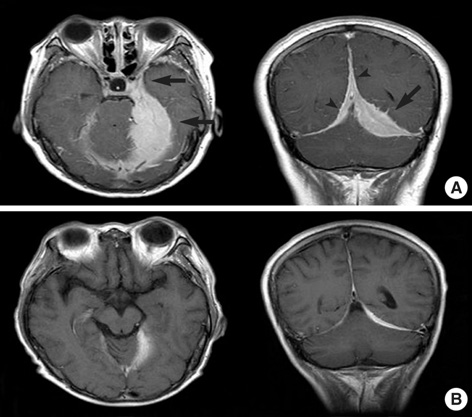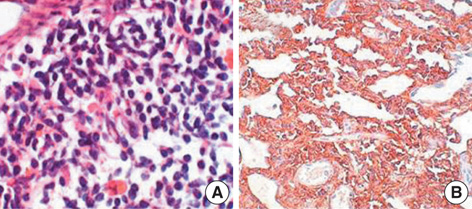J Korean Med Sci.
2007 Dec;22(6):1079-1081. 10.3346/jkms.2007.22.6.1079.
Therapeutic Experience of Bing-Neel Syndrome Associated with Waldenstrom's Macroglobulinemia
- Affiliations
-
- 1Department of Internal Medicine, Yeoungnam University College of Medicine, Daegu, Korea. hms@medical.yu.ac.kr
- 2Department of Diagnostic Laboratory Medicine, Yeoungnam University College of Medicine, Daegu, Korea.
- KMID: 1785774
- DOI: http://doi.org/10.3346/jkms.2007.22.6.1079
Abstract
- Waldenstrom's macroglobulinemia is an uncommon low-grade B-cell lymphoproliferative disorder in which monoclonal immunoglobulin M is produced. Neurological symptoms due to hyperviscosity are frequent manifestations of Waldenstrom's macroglobulinemia. However, central nervous system infiltration by plasmacytoid lymphocytes (Bing-Neel syndrome) has only rarely been reported. We report a case of a 51-yr-old woman suffering from Waldenstrom's macroglobulinemia who complained of persistant headache. Brain magnetic resonance imaging revealed an extra-axial soft tissue mass along the left cavernous sinus, left tentorium, right tentorium, and falx cerebri. A stereotactic biopsy of dural tissue from the falx was performed and showed plasmacytoid lymphocyte infiltration. The patient became symptom- free with irradiation of the whole brain followed by chemotherapy with fludarabine.
MeSH Terms
Figure
Reference
-
1. Waldenstrom J. Incipient myelomatosis or "essential" hyperglobulinemia with fibrinogenopenia-a new syndrome? Acta Med Scand. 1944. 117:216–222.2. Harris NL, Jaffe ES, Diebold J, Flandrin G, Muller-Hermelink HK, Vardiman J, Lister TA, Bloomfield CD. The World Health Organization classification of neoplastic diseases of the hematopoietic and lymphoid tissues. Report of the Clinical Advisory Committee meeting, Airlie House, Virginia, November, 1997. Ann Oncol. 1999. 10:1419–1432.3. Dimopoulos MA, Alexanian R. Waldenstrom's macroglobulinemia. Blood. 1994. 83:1452–1459.
Article4. Civit T, Coulbois S, Baylac F, Auque J. Waldenstrom's macroglobulinemia and cerebral lymphoplasmocytic proliferation: Bing and Neel syndrome. Apropos of a new case. Neurochirurgie. 1997. 43:245–249.5. Bing J, Neel A. Two case of hyperglobulinemia with affection of the central nervous system on a toxi-infection basis. Acta Med Scand. 1936. 88:492–506.6. Waldenström J. Incipient myelomatosis or "essential" hyperglobulinemia with fibrinogenopenia-a new syndrome? Acta Me Scand. 1944. 117:216–247.7. Scheithauer BW, Rubinstein LJ, Herman MM. Leukoencephalopathy in Waldenstrom's macroglobulinemia: immunohistochemical and electron microscopic observations. J Neuropathol Exp Neurol. 1984. 43:408–425.8. Edgar R, Dutcher TF. Histopathology of the Bing-Neel syndrome. Neurology. 1961. 11:239–245.9. Imai F, Fujisawa K, Kiya N, Ninomiya T, Ogura Y, Mizoguchi Y, Sano H, Kanno T. Intracerebral infiltration by monoclonal plasmacytoid cells in Waldenstrom's macroglobulinemia-case report. Neurol Med Chir (Tokyo). 1995. 35:575–579.10. Logothetis J, Silverstein P, Coe J. Neurologic aspects of Waldernstrom's macroglobulinemia: report of a case. Arch Neurol. 1960. 3:564–573.11. Tommasi M, Revol L, Schott B, Lesbros F. Waldenstrom's macroglobulinemia. Lesions of the central nervous system. Ann Anat Pathol (Paris). 1966. 11:309–313.12. Case Records of the Massachussetts General Hospital (Case 8-2001). N Engl J Med. 2001. 344:832–839.13. Leger JM, Younes-chennoufi AB, Zuber M, Bouche P, Jauberteau MO, Dormont D, Danon F, Baumann N, Brunet P. Frequency of central lesions in polyneuropathy associated with IgM monoclonal gammopathy: an MRI, Neurophysiological and immunochemical study. J Neurol Neurosurg Psychiatry. 1992. 55:112–115.
Article14. Neau JP, Guilhot F, Dumas P, Besson I, Rivasseau-Jonveaux T, Gil R. Central nervous system involvement in Waldenstrom's disease. Bing-Neel syndrome. 3 cases. Rev Neurol (Paris). 1991. 147:56–60.15. Torrey JJ, Katakkar SB. Treatable meningeal involvement in Waldenstrom's macroglobulinemia. Ann Intern Med. 1984. 101:345–347.
Article16. Kohli CM, Kawazu T. Solitary intracranial plasmacytoma. Surg Neurol. 1982. 17:307–312.
Article17. Richards AI. Response of meningeal Waldenstrom's macroglobulinemia to 2-chlorodeoxyadnosine. J Clin Oncol. 1995. 13:2476.18. Delgado J, Canales MA, Garcia B, Alvarez-Ferreira J, Garcia-Grande A, Hernandez-Navarro F. Radiation therapy and combination of cladribine, cyclophosphamide, and prednisone as treatment of Bing-Neel syndrome: case report and review of the literature. Am J Hematol. 2002. 69:127–131.
Article19. Dimopoulos MA, Zervas C, Zomas A, Kiamouris C, Viniou NA, Grigoraki V, Karkantaris C, Mitsouli C, Gika D, Christakis J, Anagnostopoulos N. Treatment of Waldenstrom's macroglobulinemia with rituximab. J Clin Oncol. 2002. 20:2327–2333.20. Monson NL, Cravens PD, Frohman EM, Hawker K, Racke MK. Effect of rituximab on the peripheral blood and cerebrospinal fluid B cells in patients with primary progressive multiple sclerosis. Arch Neurol. 2005. 62:258–264.
Article
- Full Text Links
- Actions
-
Cited
- CITED
-
- Close
- Share
- Similar articles
-
- Brain Magnetic Resolution Imaging to Diagnose Bing-Neel Syndrome
- Diffuse Large B-cell Lymphoma in Waldenstrom Macroglobulinemia
- A case of Waldenstrom's macroglobulinemia, without bone marrow involvement
- A Case of Autoimmune Hemolytic Anemia after Fludarabine Treatment in Waldenstrom Macroglobulinemia
- Utilization of Post-centrifugal Plasma Filtration for Treatment of Hyperviscosity Syndrome due to Waldenstrom's Macroglobulinemia: A Case Report



